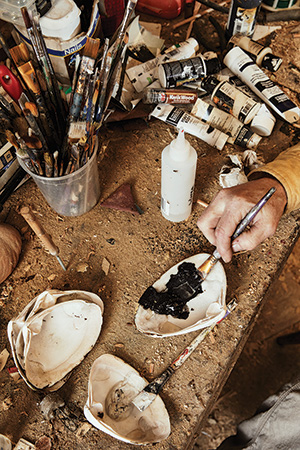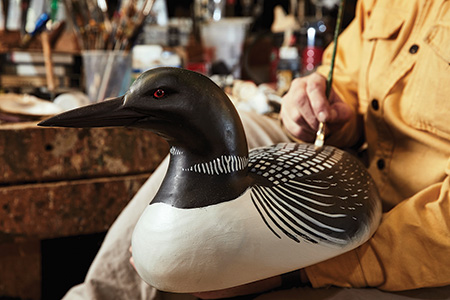For almost 40 years, Steve Brettell has worked with monkish devotion in a tiny attic workshop, crafting countless exquisitely lifelike duck decoys.
By Jaed Coffin
Photographed by Michael D. Wilson
 [dropcap letter=”I”]n a cramped attic above a 200-year-old garage in Biddeford, Steve Brettell keeps an aviary of suspended life: there are red-breasted mergansers, whimbrels, eiders, blue bills, puffins, old squaws, pheasants, goldeneyes, white-throated sparrows, black-bellied plovers — even a few duck butts. “Gotta have some duck butts,” Brettell says.
[dropcap letter=”I”]n a cramped attic above a 200-year-old garage in Biddeford, Steve Brettell keeps an aviary of suspended life: there are red-breasted mergansers, whimbrels, eiders, blue bills, puffins, old squaws, pheasants, goldeneyes, white-throated sparrows, black-bellied plovers — even a few duck butts. “Gotta have some duck butts,” Brettell says.
The carvings are done in local white pine and wrought with a minimal spread of tools: band saw, pneumatic sander, several 2-inch knives, and a handful of paintbrushes for applying acrylics and oils. In the middle of the shop, surrounded by wood shavings, is an oak bench at which Brettell sits when roughing out a body with a drawknife.
One of few full-time bird carvers in Maine, Brettell, now 60, began carving in his early 20s to support his passion for hunting sea ducks. “I didn’t have any money when I got out of college,” he says. “I couldn’t afford decoys and I thought: well, maybe I can make them! So I bought some wood and just started whacking away.” Little River Decoys was born. Brettell’s first efforts, four black ducks, still hang in his workshop. “Wouldn’t part with them for anything,” he says.
In those days, he was a park ranger at Portland Head Light and spent another 40 hours a week in the attic. After he began winning awards at decoy shows up and down the East Coast, he approached a business-mentoring program in Portland for advice. “They told me, ‘This isn’t a business. You can’t make a living doing this,’” Brettell recalls with a shrug. “I guess I just wasn’t smart enough to stop.”
Over the next 20 years, he gained a steady stream of patrons: bird people, hunters, and folks who just admired custom-made things. He also took on projects for L.L.Bean, making limited-edition buffleheads, mallards, and black ducks. In the ’80s, Brettell kept an actual aviary: a 120-by-60-foot enclosure in Old Orchard Beach with about every species of North American waterfowl. “Back then, I was basically living with them,” he recalls. He sometimes spent whole days feeding and observing his beloved birds. Those long hours allowed him to draw his subjects in living form, an experience that informs his current style: big, bold, and “full of intensity” — a characteristic he says is “all in the eyes.”

Nowadays, most decoys are plastic. They’re about 10 times cheaper than Brettell’s, lighter to carry, easier to use in the field, and less likely to break. His mentor and friend, the late L.L.Bean decoy designer George Soule, used to give him a hard time about the painstaking detail he brought to his carvings. “They don’t work any better,” Soule often chided, “so why do you put so much time into them?”
But Brettell’s purpose isn’t utilitarian. Perhaps the most striking birds in his shop are a pair of snowy owls, perched on a shelf by the window, seemingly possessed of the same calm suspicion and otherworldliness that attracted flocks of bird-watchers to Biddeford when the real owls showed up a few years ago. A nearby raven is a subtler but no less remarkable artifact. Brettell imbued it with an almost mystic iridescence that he’s tried to get just right for more than 10 years. In a certain light, the raven’s chest is green; viewed a few degrees to the left, it looks purple. He plans to keep “putting the paint to it” until he’s completely satisfied. “Nine out of ten people,” he says, “think a raven’s just black.”
 That relentless commitment to verisimilitude gets at the core intent of Brettell’s work: what he calls “life,” an elusive, almost spiritual quality. “Lots of carvings,” he says, “they’re dead.” He looks around and points to a pair of longbills. “These?” he says. “Fairly dead. But those two turkeys?” — he gestures at the birds, whose gray heads ripple with reality — “They’re definitely alive.” Seeing Brettell surrounded by so many birds in varying states of finish, it’s hard not to imagine him as a modern-day Geppetto, as if any moment one of these birds — say, that pigeon roosting above the window — might suddenly burst into flight and disappear into the winter sky.
That relentless commitment to verisimilitude gets at the core intent of Brettell’s work: what he calls “life,” an elusive, almost spiritual quality. “Lots of carvings,” he says, “they’re dead.” He looks around and points to a pair of longbills. “These?” he says. “Fairly dead. But those two turkeys?” — he gestures at the birds, whose gray heads ripple with reality — “They’re definitely alive.” Seeing Brettell surrounded by so many birds in varying states of finish, it’s hard not to imagine him as a modern-day Geppetto, as if any moment one of these birds — say, that pigeon roosting above the window — might suddenly burst into flight and disappear into the winter sky.
Brettell has a modest website, no social media platform, and no signage in front of his house. In the winter, when he really buckles down, he often works 60 hours a week in the attic, on birds that can each take anywhere from 10 to 40 hours. To drown out the silence, he plays movies on a flat-screen TV hanging in the corner. The afternoon I visit, it’s Lonesome Dove. And when he needs a break, he’ll sometimes drive along the beaches, drinking coffee and studying wild, indigenous models from his truck.
Before leaving his shop, I ask if he considers himself an artist. He cringes. “I’m just doing my work,” he says, then recalls a trip he made to Maine College of Art a few decades ago, intending to sign up for a class, maybe learn something new. When he showed a teacher his birds, he was told that what he did wasn’t art — it was craft. The distinction confused him — art was apparently a bunch of doll heads glued to a nearby wall — but it didn’t discourage him.
“The business people told me I wasn’t a business; the art people told me I wasn’t an artist. But here I am,” Brettell says, glancing around his workshop. “Whatever it is I’m doing, I’m still here.”

